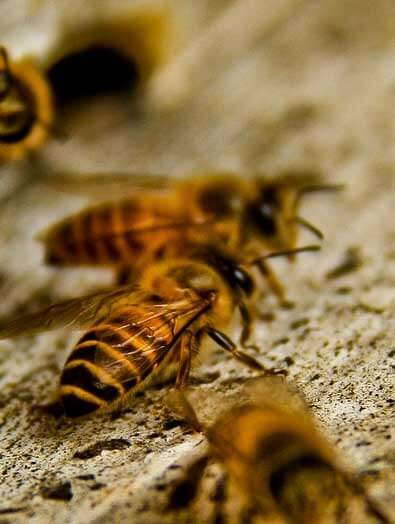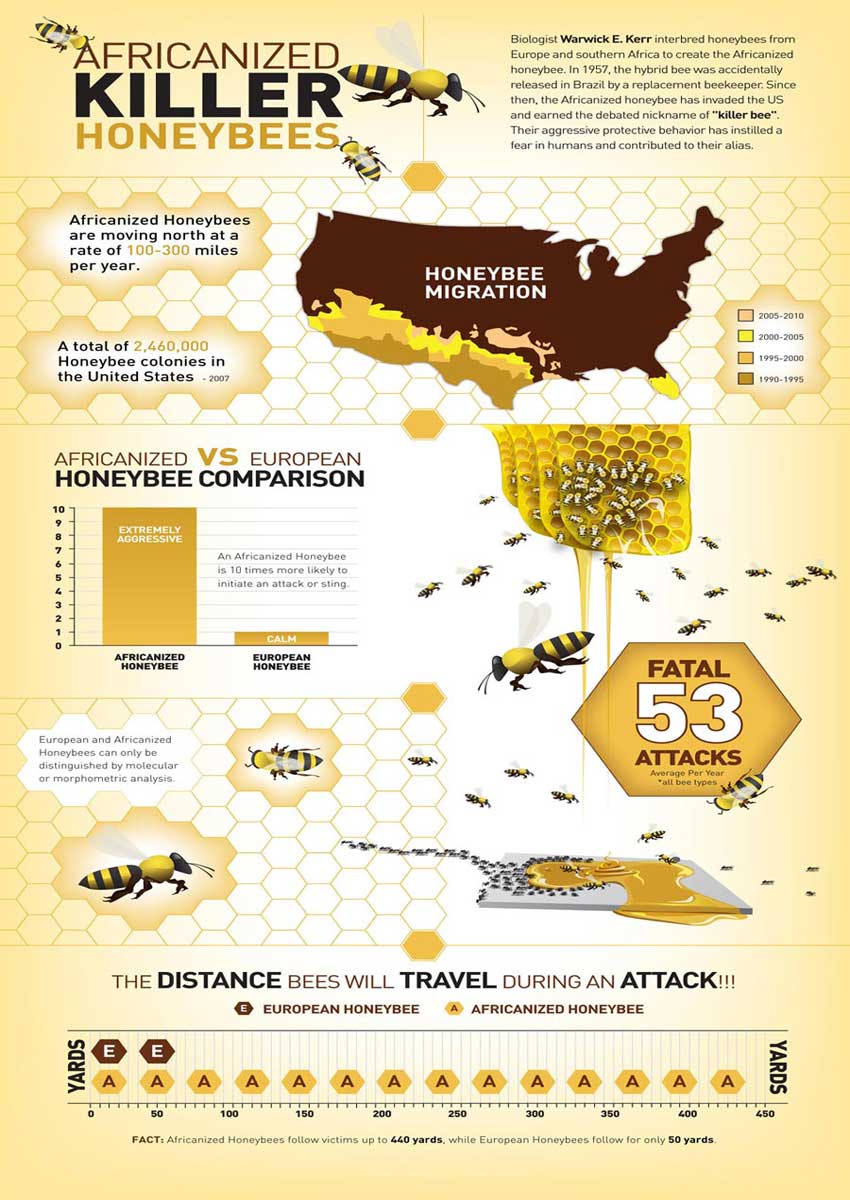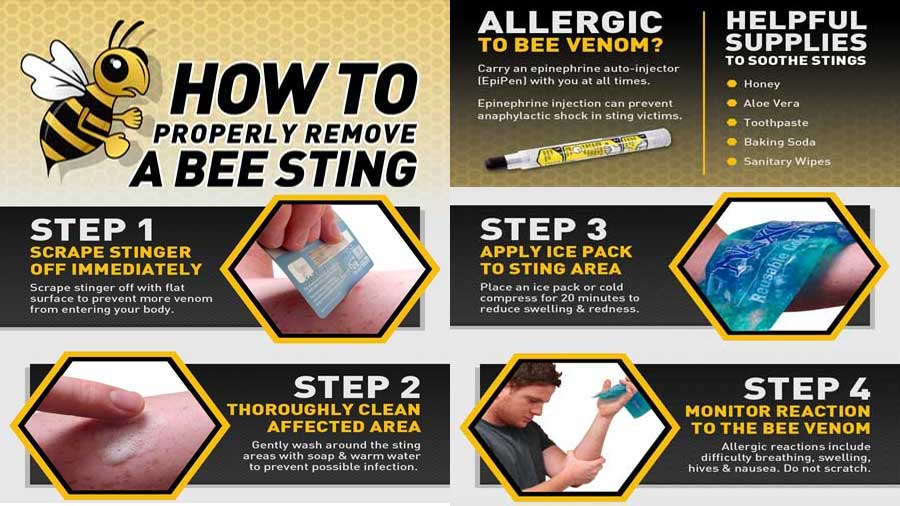A honeybee infestation is a different type of pest problem. While honeybees are beneficial to the environment, they can create health risks and structural damage when nesting inside roof eaves or the voids of a wall. Honeybees are generally docile when they do not have a nest to protect, but once honeycomb is established they can be easily provoked and attack from a slight vibration or sound. That’s why it is important to remove a honeybee infestation as quickly as possible – before they can build honeycomb. Not only because bees can be more aggressive at this point but also because large amounts of honeycomb can eventually soak into the drywall and attract a secondary infestation. Secondary pest infestations can be from ants, rodents or even bed bugs. Fortunately, there are techniques you can apply to prevent a swarm of honeybees from moving inside a structure. The procedure involves sealing up any crevices on a home so that it’s impossible for bees to enter to start building their colony. This is just one step that you can take to help fight a bee problem. Lets have a look at the exact steps!
How To Prevent A Bee Infestation
Step 1 – Inspect. This is a crucial step to keeping bees out. Bees can easily fit in a hole as small as 1/8 inch – that’s about the size of a pencil eraser. Thoroughly search the exterior of a home for an opening of this size or larger. Pay special attention to the roof eaves and corners of the siding.
Step 2 – Seal. Once you have identified all potential entry points for bees, you will need to seal them with durable materials. This can be done with caulking, stucco, plaster, or wire mesh, depending on the area where the gap is present. Larger holes in block walls will need crumpled up newspaper to be pushed into the hole before the plaster or stucco, in order to provide a good seal. Insulating foam is easier to install but is only a temporary fix since the bees can chew through the foam. Inserting steel wool before applying the foam is recommended.
Step 3 – Check. Perform monthly inspections of sealed areas and look for new potential entries for bees. If insulating foam was used, make sure it is not loose or knocked out. If the bees want entry into an area covered by foam, they can find a way. While bee prevention techniques are far less difficult and dangerous than removing a hive from your property, not every household implements prevention methods before a swarm of bees arrive. Here are some steps to follow if you decide to remove a bee infestation yourself, however, it is recommended to contact a professional if you have zero experience with handling bees.
How To Remove A Beehive From Inside A Structure
Recommended Items For Bee Removal:
- Bee Suit – this will protect you against the painful stings that bees can inflict.
- Bee Vacuum – this allows you to collect the bees after smoke has been applied to calm them down. Note: Its possible to use it without smoke but its way easier when the bees are docile.
- Bee Smoker – This small device will hold flammable items such as small wood chips, paper, etc. and when lit, will push out a large amount of smoke into the hive (make sure you place it in the correct area). It will also keep the flames within the device so you don’t run the risk of starting a fire in your back yard!
- Wood chips or newspaper – These will be placed inside your bee smoker, as the previous step mentioned.
- Mini circular saw – This is sometimes needed to completely remove the honeycomb if it is tightly lodged in some instances.
- Epi-pen – this small injection can save your life if you get a severe allergic reaction from the stings of a single or multiple bees. Of course, provided you are using your bee suit, chances are that you will not need it. However, its always good to keep one handy just in-case.
- Nail Puller – This is a critical component for removing a large hive of bees. Sometimes the honeycomb can be rather difficult to remove without using this device to loosen it.
- Spray Paint – This can be used to fix up any damaged area around the honeycomb.
Step 1 – Identify The Insect.Honeybees are often mistaken for wasps or other types of bees. Observe the bug’s characteristics from a safe distance to correctly identify your problem. Honeybees have an orange/yellow abdomen body with black rings around the abdomen and hair on their thorax. Wasps have a smooth body texture and can be a variety of colors. A honeybee’s nest is usually hidden underneath a covering and is made up of wax combs. Wasps usually have their nests exposed and consist of paper or mud nests.
Step 2 – Find The Location Of the Beehive. A hive and a swarm are two different things. If you are noticing an exposed clump of bees somewhere on the exterior of your property, it’s likely a swarm. Swarms are bee colonies that are in-between nests searching for a new place to live. Swarms are not permanent; they will usually leave in 1 to 3 days to move in a nearby location. A hive on your property can be confirmed by heavy bee activity entering a specific area on your property. Often the bees will enter through a hole in the siding, roof eaves, or irrigation boxes.
Disclaimer: These last two steps are highly recommended to be done with someone with previous experience with bees and some carpentry skills.
Step 3 – Remove the Bees. Light wood chips or newspaper in a smoker can to apply smoke in the general area to calm the bees. If bees are in a wall cavity, cut out a portion of the wall to access the hive. Continue to use the smoker when the hive is exposed. Start collecting the bees on the honeycomb with the specialized bee vacuum.
Step 4 – Remove the Honeycomb. When a majority of the bees have been removed – some will still be flying around – use a nail puller or other flat edge to dislodge the honeycomb. Thoroughly clean up any residue and spray paint any area that came in contact with the honeycomb to eliminate pheromone scents.
Step 5 – Repair The Cut Out. If the original materials you removed to access the hive are not damaged, you can use to repair the opening.
The Difference Between European Africanized “Killer” Bees
Not all honeybees are the European Honeybees, in fact the dreaded Africanized “Killer” Bees have become more prevalent in the United States with new territories being claimed as Africanized. Physically, the European and Africanized bees are almost indistinguishable, but their behaviour is where they differ. Africanized bees are far more aggressive and will pursue a victim for further distances in a bee attack. Also, they are easily provoked, the slightest noise or motion can send them into attack mode.
In conclusion, dealing with these insects doesn’t need to be the end of the world. While they may be irritating, unless they are disturbed, most bees (except the aforementioned “killer bees”) will leave you alone. However, its always a good idea to get rid of them is they are affecting your quality of life. There are a few DIY tips in this article that can be very effective, especially for small honeycombs with only a few bees. When dealing with larger infestations or if you are unfamiliar with the bee removal process, I highly recommend finding an expert removal service like Pacific Bee Removal to help you out for a very affordable price. If you enjoyed this article, please share it on twitter or any other social network you prefer.
Hello! My name is Natasha, and I have been helping people with their insect problems since 2012. I have published a book, worked with many pest control companies, and helped thousands with various infestations on a one-to-one basis. My goal for this blog is to create evidence-based guides that are easy to understand, provide sufficient depth and can be trusted to be very accurate. Please remember that my guides are for informational purposes only, and that you agree to the terms of use when reading content on this website. If you leave a comment, I typically respond within 48 hours.







Do you have any advice for carpenter bees?
Hey Beth. Absolutely, glad that you asked 🙂 Here are a few actionable steps that you can follow:
1) Use a mixture of boric acid and water to spray down their living areas. Please be careful, if you feel nervous about doing this, please call in a professional.
2) Use steel wool to seal up their holes (they cannot chew through metal)
That sound keep you busy for a little awhile, let me know if you need further help!
Hey. Great article, it’s just what I was looking for. I have just discovered a bee hive behind my garage and want to remove it. Where can i get a bee suit? or could I make something similar?
Hey Lucy! I am glad that you have found the article useful 🙂 You can purchase them online for about $70 and most of them are good quality. I suppose that you could make your own one but just be sure to use very thick material and ensure that once its on, there are no holes and sufficient protection for your eyes and face. If you are unsure, be sure to contact an exterminator as they will have all the necessary equipment already 🙂